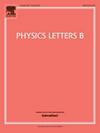用ATLAS探测器寻找在[公式省略]=13 TeV的pp碰撞中希格斯玻色子衰变为Z玻色子和轻强子衰变共振
IF 4.5
2区 物理与天体物理
Q1 ASTRONOMY & ASTROPHYSICS
引用次数: 0
摘要
利用ATLAS探测器在LHC Run 2期间记录的13tev质子-质子碰撞的完整140 fb−1数据集,对希格斯玻色子衰变为Z玻色子和质量为0.5-3.5 GeV的光共振进行了搜索。考虑了Z玻色子的轻子衰变和光共振的强子衰变。共振可以解释为J/ψ或ηc介子,类轴子粒子,或在双希格斯双重态模型中预测的轻伪标量。由于其低质量,这种共振在实验室框架中以高洛伦兹推力产生,因此重建为单个小半径强子射流。利用边带区域的数据,利用神经网络对蒙特卡罗模拟的总期望背景进行校正。另外两个神经网络用于区分信号和背景,提高了信号区域的纯度。对最终状态不变的质量分布进行了分箱轮廓似然拟合。没有观察到相对于预期背景的显著事件过剩,并且在95%置信水平上设置了希格斯玻色子分支分数到Z玻色子和光共振的上限。低质量的排除限为~ 10%,高质量的排除限增大。类轴子粒子与希格斯玻色子和Z玻色子的有效耦合CZHeff/Λ的上限也设定在95%的置信水平,范围为0.9 ~ 2 TeV−1。本文章由计算机程序翻译,如有差异,请以英文原文为准。
Search for Higgs boson decays into a Z boson and a light hadronically decaying resonance in pp collisions at s=13 TeV with the ATLAS detector
A search for decays of the Higgs boson into a Z boson and a light resonance, with a mass of 0.5–3.5 GeV, is performed using the full 140 fb−1 dataset of 13 TeV proton–proton collisions recorded by the ATLAS detector during LHC Run 2. Leptonic decays of the Z boson and hadronic decays of the light resonance are considered. The resonance can be interpreted as a or meson, an axion-like particle, or a light pseudoscalar predicted in two-Higgs-doublet models. Due to its low mass, this resonance is produced with a high Lorentz boost in the laboratory frame and therefore reconstructed as a single small-radius jet of hadrons. A neural network is used to correct the Monte Carlo simulation of the total expected background using data from sideband regions. Two additional neural networks are used to distinguish signal from background, enhancing the purity of the signal region. A binned profile-likelihood fit is performed on the final-state invariant mass distribution. No significant excess of events relative to the expected background is observed, and upper limits at 95% confidence level are set on the Higgs boson's branching fraction to a Z boson and a light resonance. The exclusion limit is ∼10% for the lower masses, and increases for higher masses. Upper limits on the effective coupling of an axion-like particle to a Higgs boson and Z boson are also set at 95% confidence level, and range from 0.9 to 2 TeV−1.
求助全文
通过发布文献求助,成功后即可免费获取论文全文。
去求助
来源期刊

Physics Letters B
物理-物理:综合
CiteScore
9.10
自引率
6.80%
发文量
647
审稿时长
3 months
期刊介绍:
Physics Letters B ensures the rapid publication of important new results in particle physics, nuclear physics and cosmology. Specialized editors are responsible for contributions in experimental nuclear physics, theoretical nuclear physics, experimental high-energy physics, theoretical high-energy physics, and astrophysics.
 求助内容:
求助内容: 应助结果提醒方式:
应助结果提醒方式:


